This is a good news/bad news day…….the good news is that there is an early morning (7:00 am) flight from Addis to Gondar that arrives at 8:30 am, so we have the whole day to visit projects in the Gondar area. The bad news is that you have to get up at 4:30 am to catch the flight!
Today we will be with representatives from Glimmer and implementing partner in this region, Organization for Rehabilitation and Development in Amhara (ORDA). With Glimmer, W2T began working with ORDA in 2010, implementing two groups of projects for 2010 and 2011. We also have a major deep borehole project underway with ORDA for the community of Robit (7,000), which we will visit tomorrow.
Today we will be visiting projects in the kebele (like a county) of Degola Chimchaye that were part of the projects implemented in 2010 and 2011 with ORDA. As part of our process, we regularly revisit projects after they are complete to check on their sustainability and the progress of the community. We visited a number of these projects on our trip this last June and noticed a number of the projects had drainage and potential flooding issues because of the physical location of the well. The wells are often located in low lying areas as natural part of the location of the best water tables.
After our visit, our partners revisited all of the sites and developed a remediation plan for those sites that needed improvement. Our first visit was to the site of Senkor Mensk II. Our partners have now built a water diversion retaining wall around three sides of the water project which you can see behind the pump in this picture.
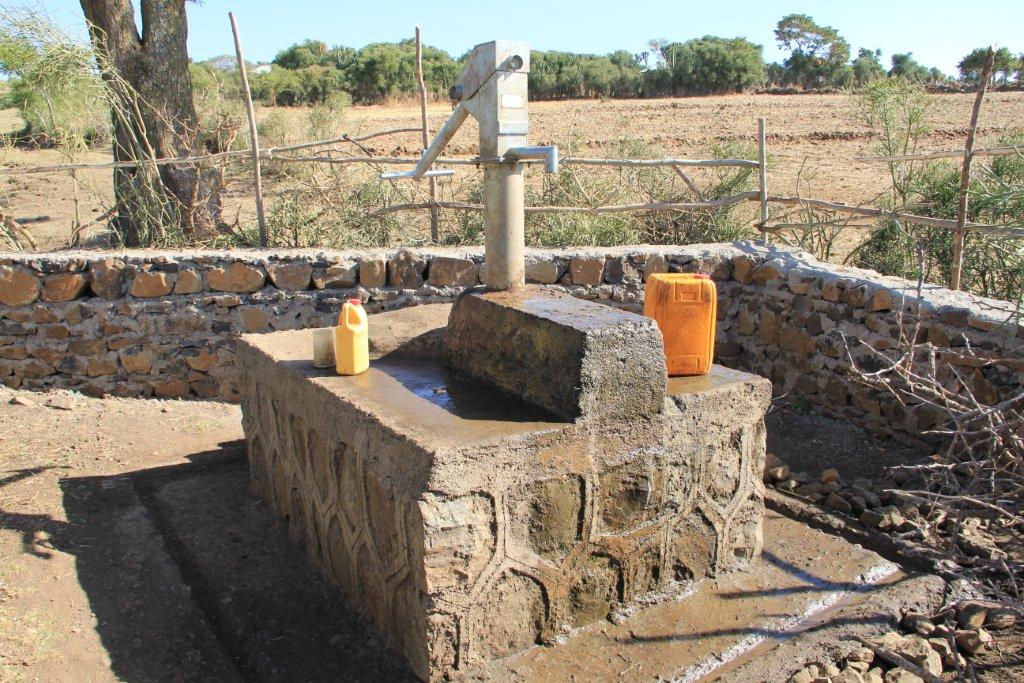
The diversion wall will direct the flow of any water coming down the valley away from and around the water project. This insure that the well will not be contaminated nor structurally weakened by the fast running water during the rainy season
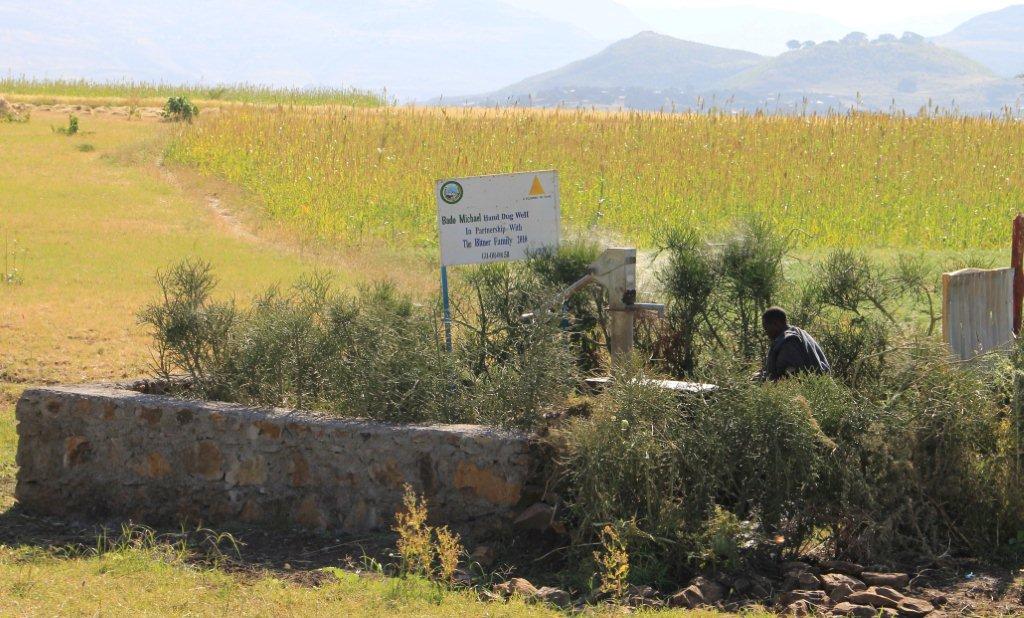
Our next stop was the project at Bado Michael, which also needed the diversion wall. This picture gives a better overall view of the site and you can see how the wall surrounds the project on the uphill side of the water project. Even if this area is flooded during the rainy season, the well will be completely protected
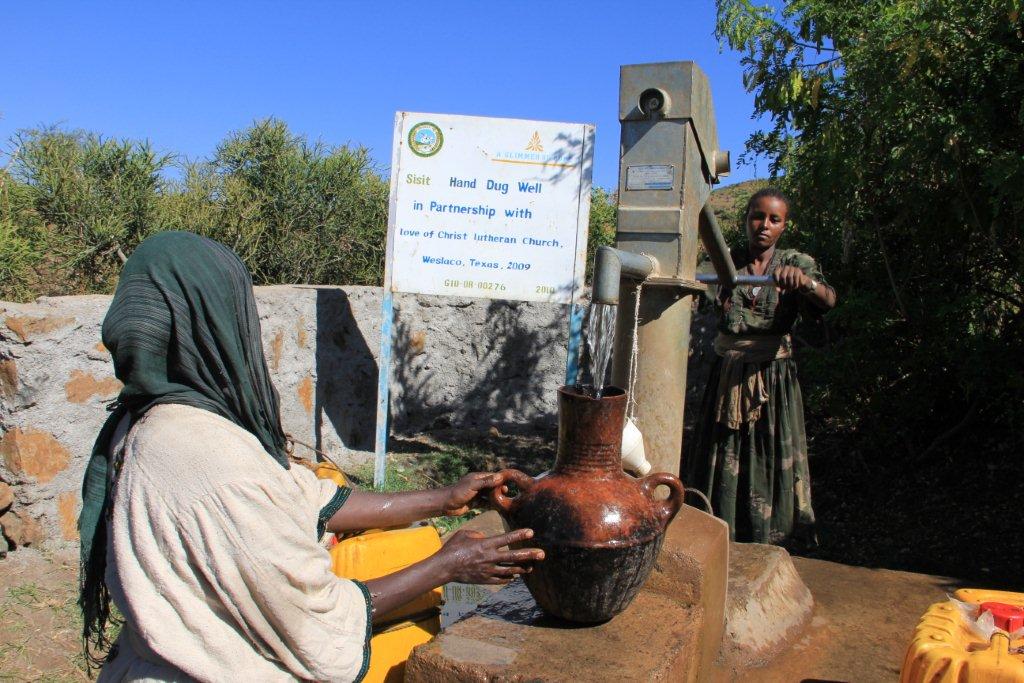
We next visited the project site at Sisit. You can see the diversion wall in the background of this picture as well. When we arrived, we noticed a woman with a clay pot waiting her turn to fetch water from the pump. It is actually rare these days to see the clay pots…..as they have been replaced by the ubiquitous yellow jerry cans.
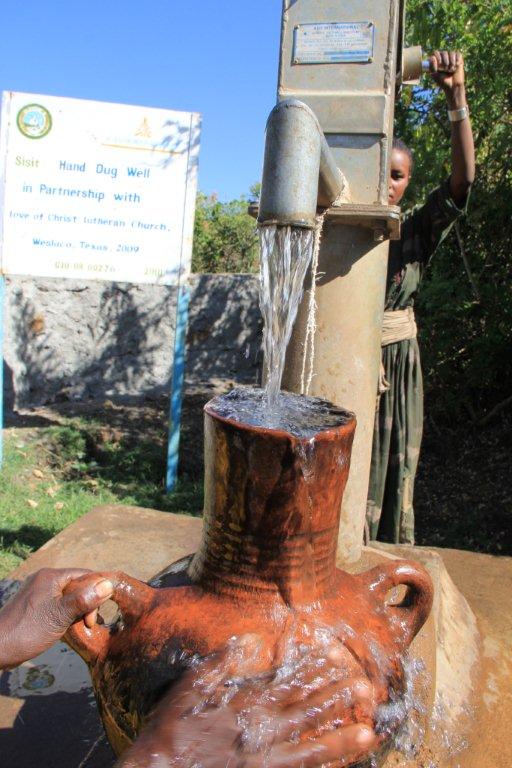
The clay pots, when filled with water weigh close to 55-60 pounds instead of about 45 pounds for the plastic jerry cans. Curious about her choice, we struck up a conversation with the owner of the pot.
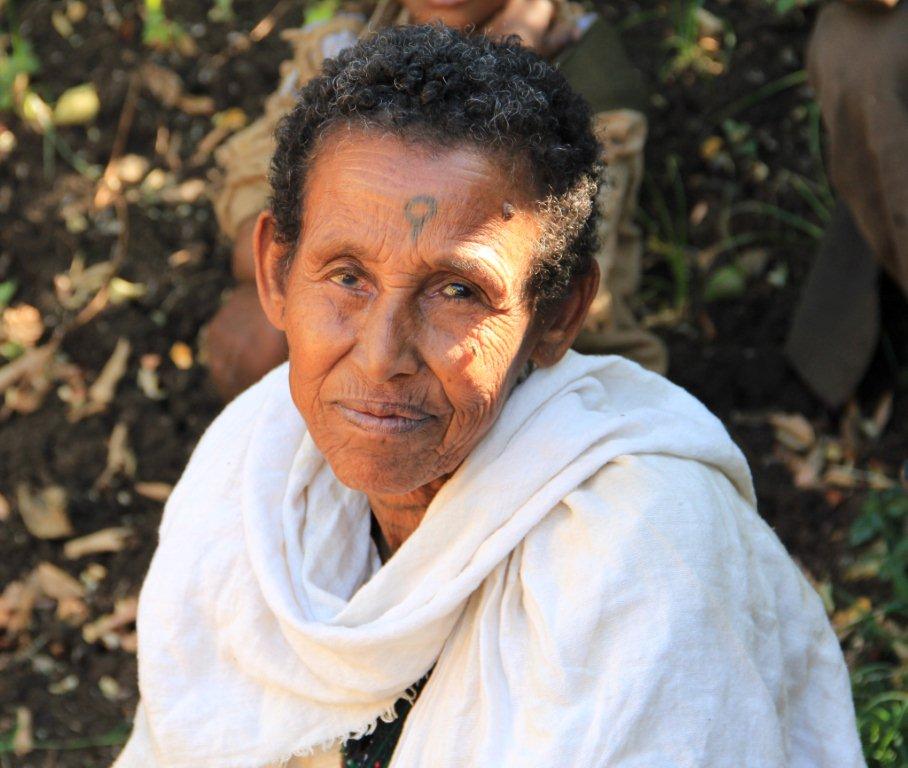
Meet Yirgadu Mekonnen, 62, mother and grandmother! She has 8 children, and for the grand children, she said “well, it is just too many to count!” One of her sons was there and he serves on the Water Council for Sisit. Yirgadu was born in Sisit and lived here all her life. She has been carrying the clay pots since she was a small child and finds them “just more comfortable to carry”. She doesn’t ever plan to change to the plastic kind. She was quick to add her gratitude for the Sisit water project which is just a short walk to her home. Previously, she was gathering water from the river that runs through the valley.
We begin our trip back to our vehicles (45 minute walk) a different direction so we can go another water project near the Abakaleyu primary school (a new school block built by Glimmer). The water project was furnished by W2T to primarily serve the needs of the school children, but it is also used by the community.
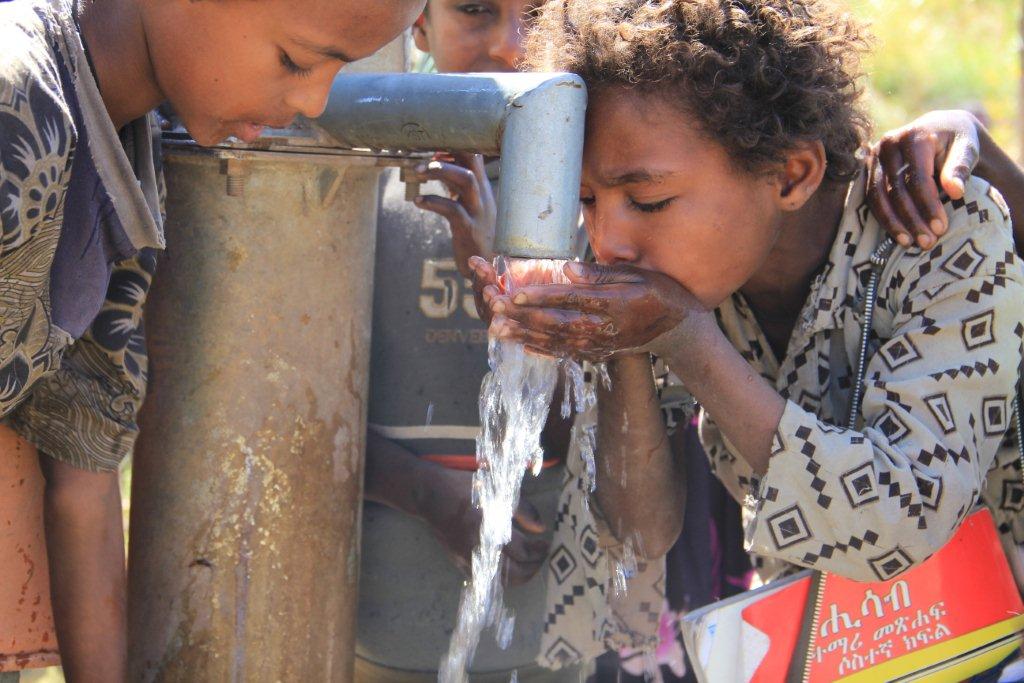
When we arrive at the well, we discover school has just released, and there are about 40 children waiting to get water from the water well. There was a little pushing and shoving when everyone saw the camera, but everyone enjoyed getting the picture taken getting a cool drink of clean water!
As we made our way on toward the vehicles, we passed by a farmer’s large field. Since this area is in a river valley, he has diverted water from the river by trenching to provide irrigation for the crops.
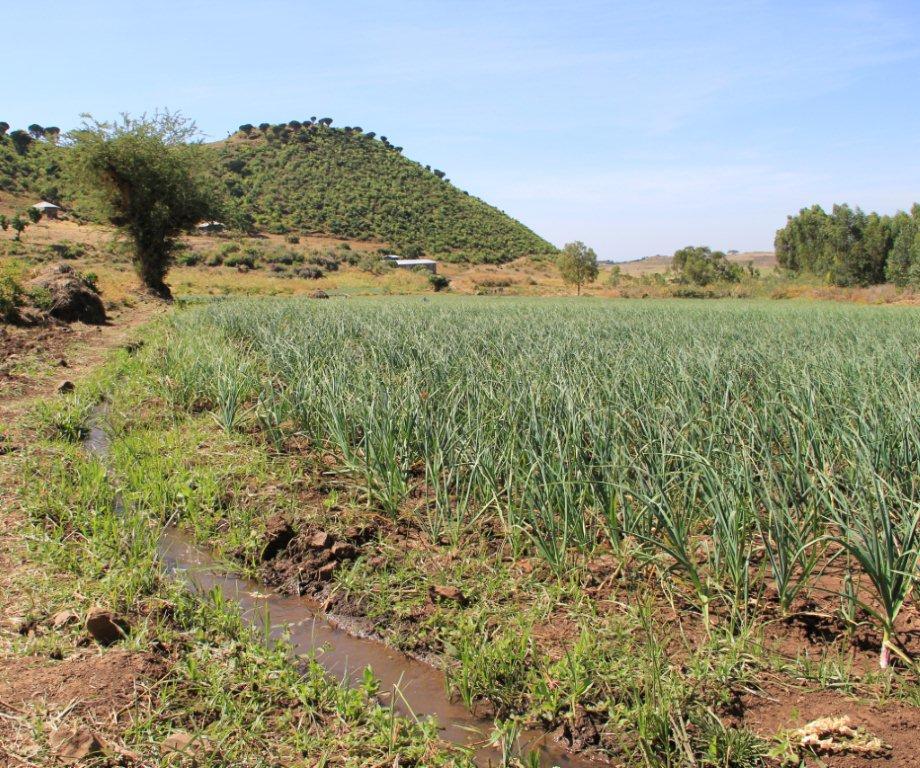
The result is this beautiful crop of onions, which are loving the water. This will be a major cash crop for the farmer as he take his onions to the local market. With irrigation he can get two crops per year.
This is a good news/bad news day…….the good news is that there is an early morning (7:00 am) flight from Addis to Gondar that arrives at 8:30 am, so we have the whole day to visit projects in the Gondar area. The bad news is that you have to get up at 4:30 am to catch the flight!
Today we will be with representatives from Glimmer and implementing partner in this region, Organization for Rehabilitation and Development in Amhara (ORDA). With Glimmer, W2T began working with ORDA in 2010, implementing two groups of projects for 2010 and 2011. We also have a major deep borehole project underway with ORDA for the community of Robit (7,000), which we will visit tomorrow.
Today we will be visiting projects in the kebele (like a county) of Degola Chimchaye that were part of the projects implemented in 2010 and 2011 with ORDA. As part of our process, we regularly revisit projects after they are complete to check on their sustainability and the progress of the community. We visited a number of these projects on our trip this last June and noticed a number of the projects had drainage and potential flooding issues because of the physical location of the well. The wells are often located in low lying areas as natural part of the location of the best water tables.
After our visit, our partners revisited all of the sites and developed a remediation plan for those sites that needed improvement. Our first visit was to the site of Senkor Mensk II. Our partners have now built a water diversion retaining wall around three sides of the water project which you can see behind the pump in this picture.

The diversion wall will direct the flow of any water coming down the valley away from and around the water project. This insure that the well will not be contaminated nor structurally weakened by the fast running water during the rainy season

Our next stop was the project at Bado Michael, which also needed the diversion wall. This picture gives a better overall view of the site and you can see how the wall surrounds the project on the uphill side of the water project. Even if this area is flooded during the rainy season, the well will be completely protected

We next visited the project site at Sisit. You can see the diversion wall in the background of this picture as well. When we arrived, we noticed a woman with a clay pot waiting her turn to fetch water from the pump. It is actually rare these days to see the clay pots…..as they have been replaced by the ubiquitous yellow jerry cans.

The clay pots, when filled with water weigh close to 55-60 pounds instead of about 45 pounds for the plastic jerry cans. Curious about her choice, we struck up a conversation with the owner of the pot.

Meet Yirgadu Mekonnen, 62, mother and grandmother! She has 8 children, and for the grand children, she said “well, it is just too many to count!” One of her sons was there and he serves on the Water Council for Sisit. Yirgadu was born in Sisit and lived here all her life. She has been carrying the clay pots since she was a small child and finds them “just more comfortable to carry”. She doesn’t ever plan to change to the plastic kind. She was quick to add her gratitude for the Sisit water project which is just a short walk to her home. Previously, she was gathering water from the river that runs through the valley.
We begin our trip back to our vehicles (45 minute walk) a different direction so we can go another water project near the Abakaleyu primary school (a new school block built by Glimmer). The water project was furnished by W2T to primarily serve the needs of the school children, but it is also used by the community.

When we arrive at the well, we discover school has just released, and there are about 40 children waiting to get water from the water well. There was a little pushing and shoving when everyone saw the camera, but everyone enjoyed getting the picture taken getting a cool drink of clean water!
As we made our way on toward the vehicles, we passed by a farmer’s large field. Since this area is in a river valley, he has diverted water from the river by trenching to provide irrigation for the crops.

The result is this beautiful crop of onions, which are loving the water. This will be a major cash crop for the farmer as he take his onions to the local market. With irrigation he can get two crops per year.

About The Author: Meredith
More posts by Meredith